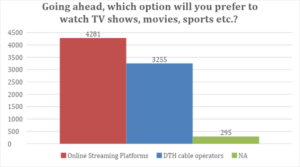Regulation of OTT Platforms in India

________________________________________________________________________________
This Blog is written by Illa Mathi Maran from UPES, Dehradun. Edited by Ravikirna Shukre.
________________________________________________________________________________
INTRODUCTION:
In this ongoing pandemic situation, various countries implemented lockdowns and proposed various restrictions among the people. If we list out the familiar leisure time activity of most people will be listed under the category of cinephiles. In today’s trend, most people were passionate about watching movies on various OTT platforms. What is this OTT mean? are there any regulations and restrictions for it? These are the questions we will be encountered while we study these OTT platforms.
The term OTT referred to over–the–top platforms. If we saw the statics of the users in these OTT platforms, young Indians, under 35 years of age accounted for 89% of the total usage of these platforms [1] Various craze cinephiles are using these OTT platforms as their daily leisure time. These over-the-top platforms are the main players in this period. During the past nine months, several VOD providers have registered a huge number of paid -subscriptions and views [2] Various issues are deled in these OTT platforms, for the sake of continuous views on these platforms internet limitations play a major role in it. People were craving for an unlimited data package to watch their movies and series on this OTT platform.
These OTT platforms have been there since 2008. It was introduced by BIGFIX, and later on due to high demand, more companies started providing OTT platforms such as DITTO TV, SONY LIV into the Indian market. But at that point in a period, most people were interested in watching movies in theatres rather than on these types of platforms. Due to the COVID situation, government guidelines to shut down public places such as malls, theatres, etc., though these platforms are getting more opportunity to start growing in a huge basis and high market.
As we have already seen the development of these OTT platforms, to regulate these platforms government made a special amendment in the government of India (allocation of business) rules, 1961. The contents on these platforms were assigned to be maintained by the ministry of information and broadcasting.
This article will mainly describe the new amendment and also the significance and development of these OTT platforms.
SIGNIFICANCE IN DEVELOPMENT IN OTT PLATFORMS:
The development of a media platform should have some important factors to develop. If we take OTT platforms we could say rooting in increasing growth in mainstream media consumption by inline media stream services. Many media stream services are flourishing with advertisements to attract more people to the platform. Due to this vast advertisement, these platforms have become a compulsory and necessary part. Is that considered important?
There are some of the factors which influence peoples to fallow these platforms such as
• ORIGINAL CONTENT FOR VIEWERS:
The person who got the subscription in any one of these OTT platforms will get instant movies, series, movie shows, etc… efficiency is also an important factor which the people got attracted to it. The subscription cost was also less in some of the platforms to mainly attract the people to get the paid subscription
• COMPATIBILITY IN NUMEROUS DEVICES:
In the traditional method, people were relied on radios and further on to the television as their entertainment. In this era, there are lots of devices and equipment for entertainment purposes such as MOBILE PHONES, PERSONAL COMPUTER, SMART TV, there are various types includes SMART TV, NORMAL TV, VIDEO GAME CONSOLES.

[THIS IS THE SURVEY RESULT WHICH WAS TAKEN TO COME INTO THE CONCLUSION] [3]
Numerous platforms are mesmerizing the people to get their plaid subscriptions, but we can’t blame fully on these platforms. The victim could be us (people) to take the liability. The people were craving for their movies, series, and TV shows. The people were being demanded unlimited data to get non–stop the fun to enjoy the movies. These wishes were used by most of the companies and working to fulfill them. The resultant of these activities results in various environmental issues like GLOBAL WARMING, DYING OF SPARROWS ETC… these are some of the current problems which are faced by most of the developing countries.
IMPACT:
Due to some of the major issues both the parties (people and platforms). Were equally affected. By this statement, there might be a question like DO OTT PLATFORMS FACE CHALLENGES?
Certainly, yes there are various problems and impacts on both sides.
• The main problem could be competition among the other platforms. For gaining more attraction these platforms provide various offers and discounts for the subscribers by these platforms.
• These days NETFLIX is the major crave among peoples, but this is not the only platform to function. Various platforms provided extra services such as music, radio, comics, etc… so the competition among these platforms are pretty stiff
• The growing new platforms made a huge confusion among the people to go in a particular way. g.: DISNEY as the recent platforms launching the services in recent years. HBO is also considered as a game-changer on the competition among the OTT platforms
Apart from the larger companies or platforms, various small-scale platforms are working to get more subscriptions and the growth of their user’s percentage. Due to these OTT platforms, there were various job opportunities and technological development in our nation. “We should always see another side of the coin”.
Despite these OTT platforms are making the people in an addictive way, they were also providing job opportunity and holds a thriving industry we should consider this statement by numerous statements and material facts in a continuous manner
• These OTT platforms were gaining a global market and viewers. There are viewers from Asia, the north pacific and the whole world are streaming the movies and series all long.
• These OTT platforms are not only providing entertainment to the people they are also providing educational purposes such as scholarships, funds, etc… And also provide institutional streaming services.
• These platforms have specific goals for the sake of the people’s advantages, such as the advent of 5G services. These goals were made a huge impact in making our country versatile, diverse and competitive OTT industry.
STATUTORY PROVISIONS:
If we analyze the legal view of these OTT platforms, there are no specific laws to regulate their actions. But statutes are not strict and direct, but they provide indirect check-in these platforms. There are some sets of sections and articles for regulating content available online.
• ARTICLE 19 of the Indian constitution [4] gives FREEDOM OF SPEECH, there are numerous interpretations for these terms. This freedom of speech is not only limited to the people they were also applicable to publications like a magazine, news press, etc… the freedom which is provided in this section is not absolute, there are some checks in this section mentioned in Article 19(2) that during the content of the state, hamper of the public order, international relations are aimed to the inciting of the crime will not be applicable.
• Section 293 provides punishment for such persons who are indulged in the selling and the distribution of the literature which are obscene. The publisher which is publishing defamatory content about the government or women will be punishable under section Section 499 and 354 of the Indian Penal Code
• For those persons who are publishing any of the obscene material or any of the sexually explicit materials or child-related sexual act, those contents publishers will be punished under Section 67A, 67B and 67C of the information technology act, 2000. [5]
• The protection of children from sexual offenses acts that made the offense of selling and distributed child pornography by POCSO Act. [6]
• Incent representation of women (prevention) act, 1986 that made sure prohibition defamatory content of Section 345 of the Act.
Thus, there is no explicit law for the regulation for OTT platforms, they were united together and formed the institution signed to make the self-regulatory code. These provide the best content providers and mobile association of India (IAMAI). They made a framework of guidelines to be followed by these platforms were listed below;
• These platforms were also insisted to made separate categories about the contents, also disclaimers were made to avoid inappropriate for the certain age group.
• Defining age-sensitive content to be available in the separation between them to make the distinctions.
• There should be a proper grievance redressal mechanism to address the concern or complaint that has been raised by consumer content available on these platforms.
These pointers were specially made for these regulations. These pointers were not appropriate to follow. Some disputes started to be happening between these platforms. Thus the new proviso was made to regulate the disputes among the OTT platforms. These provisions were also made important views as they made people think from a different angle. The view in this ambit was mainly as such as mentioned and our judiciary made a different angle in the following ways as such as mentioned above.
CASE LAWS:
These platforms also made an important view in the young youths because of their durability and constant contents. These platforms were also made an important impact among these youths to get addicted. Many of the parent’s contention towards these platforms increased and there were lots of petitions were filed to these platforms. One of the major impactful cases which are happened in the Karnataka high court was named Padmanabh Sankar v. Union Of India [7]
In this case, Padmanabha Sankar a senior citizen in Karnataka. He filed a petition in the court about OTT platforms are publishing content that is majorly affecting the growing youth people. He laid down 4 main important issues to the court such as
• The petitioner requested the court to fix a suitable regulatory authority to regulate the check and balances in these platforms
• He also requested the court to make a rule in which these platforms need to get purview of the central board of film certification (CBFC) and the Cinematography Act, 1952 to guide these platforms’ functions.
• He made content to the OTT platforms for not making safety clocks available, under Section 79 of the IT Act that procedure made mandatory.
He ended his prayer by requesting the court that available internet over the four walls or house should also be considered as the “public exhibition”.
JUDGMENT:
After hearing both sides of the argument the judge was intended to give their opinion in this case.
• They commonly stated as regarding the first prayer, “it is not possible to accept the submission that the transmission of films, series and shows will purview under Section 2(C) of the Cinematography Act”.[8]
• The second prayer is related to the first, thus both get nullified in the above point
• The court also considered his step and also ordered the state government to take look into the matter.
This case made a huge step that awaked the people from these OTT platforms. But there is no official guideline made between the public regarding the advertising codes under The Cable and Television Rule of 1994. This will surely make a huge impact on these OTT PLATFORMS.
ANALYSIS:
In my opinion, these OTT platforms are not only making people get addicted or change the mindset. We can’t give all blame on a single platform. In the defined part, OTT platforms are only providing series and show based on the people’s request. But we can’t give all freedom to them to act in their realm. Various acts are there to protect them like a central board of film certification (CBOFC), internet and mobile association of India (IAMAI), etc.[9]
If we see the current status of this amendment, it’s still in the picture. Various guidelines are made under this judgment. This judgment has mainly shifted the power to the state government to make the decisions.
If we analyze various other countries about these OTT platforms, they made various guidelines to be followed by these platforms. In unites kingdom (UK). The BBC called out the action about the platforms into consideration. Then the British board of film certification was made compulsory for partnering with NETFLIX. Also, the UK government made an issue about enforcing the EU electronic communication code (EECC).
In Singapore, the regulation of OTT platforms was made quite direct by the government they made this agreement with the guidelines of the Infocomm media development authority (IMDA), in 2018 the code was imposed into the OTT platforms to regulate the OTT platforms. There are various countries guideline the function of OTT platforms, but some countries were given the freedom to accrue its process
We are still in a developing mode of check and balance in these OTT platforms. In our country we can take fast decisions and orders, it will take some time to get processed and to get implemented.
CONCLUSION:
We are heading to a new world that is fully dependent on technology. We need development in our country, technology is also considered as a major factor for the development of the country. The mode of gaining knowledge varies from person to person, in the previous era, people thought that reading books, literature, manuscripts are the main mode of gaining knowledge. But we are in the new era of 2021 people were relying on technology for gaining knowledge. Some people gain moral values by seeing movies, watching other people’s ideas, etc., we can’t blame people based on the way they learn we need to know the value as “don’t judge a book by its cover”. So, we should consider These OTT platforms were also a different mode of our development.
REFERENCES:
For making this article I have referred to some of the news lets and websites to gather the data which I provided above
1. This statics is taken from the article published in the newspaper https://brandequity.economictimes.indiatimes.com/news/media/top-5-metro-cities-account-for-55-of-the-total-video-ott-users-while-tier-i-cities-account-for-36-of-the-users-survey/69855110
2. This data was taken fromhttps://www.financialexpress.com/brandwagon/2020-rise-of-paid-subscribers/2172942/
3. This data is taken from the information published in the newspaper https://brandequity.economictimes.indiatimes.com/news/media/55-of-indians-prefer-ott-platforms-vs-41-that-still-prefer-dth-momagic-survey/70858815
4. This article is taken from the Indian constitution https://indiankanoon.org/doc/1218090/
5. This section is taken from the information technology act https://www.indiacode.nic.in/show-data?actid=AC_CEN_45_76_00001_200021_1517807324077§ionId=13093§ionno=67A&orderno=84
6. This is a special provision for women child https://wcd.nic.in/sites/default/files/POCSO%20Act%2C%202012.pdf
7. This case law was taken from https://indiankanoon.org/doc/146705351/
8. This data is taken from the article published in the news let https://www.thehindu.com/news/cities/bangalore/online-content-cant-be-regulated-under-cinematograph-act-hc/article28864629.ece
9. This is taken from https://blog.ipleaders.in/ott-platforms-regulation/#:~:text=According%20to%20a%20new%20amendment,Ministry%20of%20Information%20and%20Broadcasting.
WEBSITES:
• https://www.trigger.digital/blog/2019/8/7/what-is-ott-over-the-top-and-why-is-it-important
NEWS LET:
• THE HINDU
• TIMES OF INDIA
• BRAND EQUITY
PROVISIONS:
• IT ACT, 2000
• CABLE NETWORK REGULATION ACT,2005

